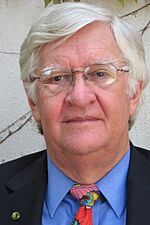Robert Hamerton-Kelly facts for kids
Quick facts for kids
Robert Hamerton-Kelly
|
|
|---|---|
 |
|
| Born | December 26, 1938 |
| Died | July 7, 2013 (aged 74) |
| Nationality | American (naturalized) South African |
| Occupation | Minister, University Professor |
| Years active | Late 20th and Early 21st Centuries |
|
Notable work
|
Sacred Violence: Paul's Hermeneutic of the Cross The Gospel and the Sacred: Poetics of Violence in Mark Violent Origins (Editor) |
| Spouse(s) | Rosemary |
| Theological work | |
| Tradition or movement | United Methodist |
| Main interests | Mimetic theory |
Robert Gerald Hamerton-Kelly (December 26, 1938 – July 7, 2013) was a Christian thinker and a United Methodist pastor. He wrote and edited several books about how religion and conflict are connected. He worked at Stanford University for over 30 years. For 14 of those years, he was the Dean of the Chapel at Stanford Memorial Church.
Robert Hamerton-Kelly was a big supporter of René Girard's idea called mimetic theory. This theory explains how people learn by copying others. Hamerton-Kelly helped start groups to study this idea. He also edited important books about it.
Early Life and Learning
Robert Hamerton-Kelly was born in Cape Town, South Africa. He went to the University of Cape Town and Rhodes University. He earned his first degree in 1958. Later, he studied at the University of Cambridge in England. There, he earned two more degrees in religious studies by 1965.
While at Cambridge, he ran cross country races. He also met his wife, Rosemary, there. They had three children together.
After moving to the United States, Hamerton-Kelly continued his studies. He earned a special doctorate degree in theology in 1965. From 1966 to 1970, he taught religion at Scripps College in California. In 1967, he became an ordained minister in the United Methodist Church. He then taught about the New Testament in Chicago from 1970 to 1972.
Working at Stanford University
In 1973, Robert Hamerton-Kelly started working at Stanford University. He became the Dean of the Chapel. This meant he was also the minister at Stanford Memorial Church. He taught students about ancient Greek used in the New Testament. He also taught about Western history and ideas.
Hamerton-Kelly was interested in how religion and conflict are linked. This led him to the work of another Stanford professor, René Girard. Girard's mimetic theory suggests that people often want what others have. This can lead to arguments and conflict. The theory also says that conflict can be solved by finding a scapegoat or through religion.
Hamerton-Kelly wrote books that looked at New Testament writings through Girard's ideas. These books include Sacred Violence: Paul's Hermeneutic of the Cross (1992) and The Gospel and the Sacred: Poetics of Violence in Mark (1994).
He also helped start the Colloquium on Violence and Religion. This group studies Girard's ideas further. In 1987, Hamerton-Kelly edited a key book called Violent Origins. It was a collection of essays from early meetings of the group.
In 1986, Hamerton-Kelly left his role at Memorial Church. He became a Senior Research Scholar at a center that studies international security. Here, he looked at ethical questions about nuclear weapons and military actions. He was very interested in ethnic conflicts in Central Europe. He traveled there in the early 1990s. This was after many countries in the region became more democratic. But this also brought out old ethnic tensions.
After Stanford and Later Years
In 1996, Hamerton-Kelly became a pastor at the Woodside Village Church in Woodside, California. He stayed there until 2004. During this time, he gave over 400 sermons. He also started a speaker series. Famous people like Condoleezza Rice and William Perry spoke at these events. After leaving Woodside, he continued to give sermons to a smaller group in Palo Alto, California.
In 2005, Hamerton-Kelly and a former student, Peter Thiel, started a group called Imitatio. This organization helps promote research on Girard's mimetic theory. Hamerton-Kelly was the first president of Imitatio from 2007 to 2010. He then retired and became Chairman Emeritus. He moved to Portland, Oregon in 2010. He passed away in 2013 after a stroke and a short illness.

